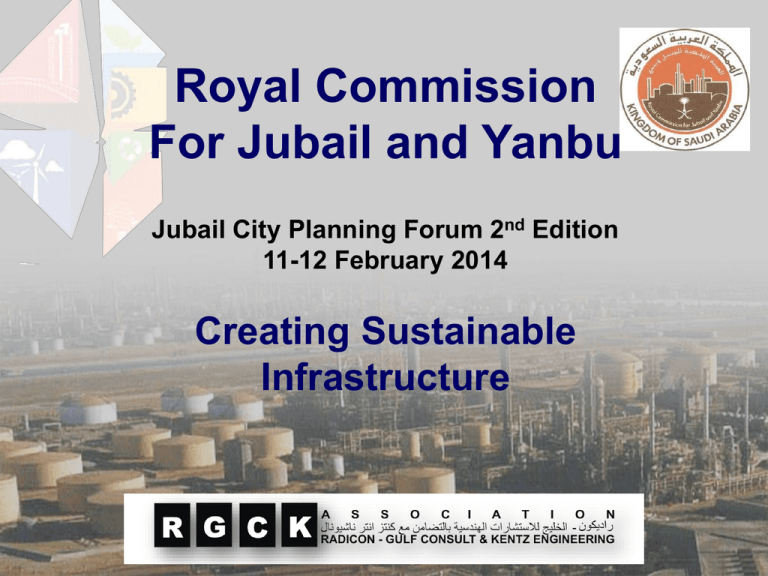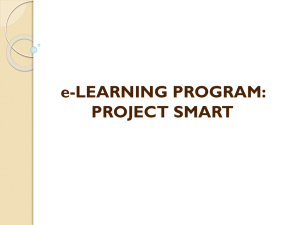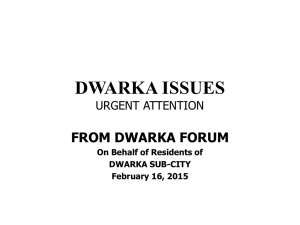- Jubail 2nd International City Planning Forum
advertisement

Royal Commission For Jubail and Yanbu Jubail City Planning Forum 2nd Edition 11-12 February 2014 Creating Sustainable Infrastructure RGCK Association is a consortium formed between Radicon Gulf Consult, an established Saudi Arabian multi-discipline consulting engineering practice & Kentz Engineering International Ltd, part of The Kentz Group who are major multi-national engineers and constructors. The association was formed to undertake The Royal Commission contracts, which require both local & international expertise. We are committed to deliver outstanding quality and performance to our clients, this is demonstrated by our certification to internationally recognized quality and environmental management standards’ BS EN ISO 9001 and BS EN ISO 14001. RGCK Association are proud to be associated with the Royal Commission of Jubail and Yanbu for over ten years. During that time the Royal Commission of Jubail and Yanbu has awarded design and engineering contracts for the Jubail 2 Industrial City to RGCK Association. The scope of the works under these contracts covers engineering studies, front end engineering and design, preparation of drawings and specifications and bid packages amounting to over 1 million engineering hours. These works cover civil and structural, roads and highways, potable water, industrial and sanitary waste water systems, electrical power and distribution systems, telecommunications. The awarded construction value of these works amounts to over $900 Million. RGCK Association are committed to be part of the future planning and development of Jubail City. Creating Sustainable Infrastructure • • • • • • Introduction Reliable Infrastructure Green Infrastructure Safe and Smart Infrastructure Human Infrastructure Conclusion Introduction Today, a world without all types of infrastructure covering water and waste water, solids and hazardous waste handling, roads, bridges, buildings and facilities, rail, aviation, sea ports telecommunications and energy would be almost unimaginable. Introduction Transport infrastructure now has a prominent, almost dominant position in our society. Comparing transport infrastructure of today with those of forty years ago it becomes clear that in the next forty years time everything will again look a lot different to how it looks today. Society’s are constantly developing and so are people’s requirements regarding the use, structure and design of transport infrastructures. The future design and construction of infrastructures may be subject to different requirements and demands. More research and clarity of the future needs, and requirements becomes essential in order to make the right choices today. Introduction Transport infrastructure is the cornerstone for all present and future towns and cities, with road networks playing a dominant role. Road transport will continue to play a major role for the movement of people and freight so we must consider best engineering and construction practices to develop all future road systems that will have the minimum impact on the environment. Introduction We now look at some of the issues that future road infrastructure research, design and construction should take into consideration when planning future developments. These are Reliable Infrastructure, Green Infrastructure, Safe and secure Infrastructure, and Human Infrastructure. With infrastructure works the problems requiring solutions are growing. A new generation of problems requires fresh approaches to provide lasting trend setting developments. Reliable Infrastructure It is common knowledge that the road engineering sector is known as traditional and conventional. Nevertheless, with the road transport demands over the last decades, the sector has responded and provided solutions to many complex problems. The sector has managed to improve the performance of road infrastructure and related components. Reliable Infrastructure The main characteristics of a reliable infrastructure are: • Available • Durable • Reliable The solutions for a reliable Infrastructure are: • Lifetime engineering • Fast, hindrance free maintenance • Balancing demand and capacity • Asset management tools. Available Roads are the lifeblood of trade and social utility. Keeping the traffic flowing is the main concern of all road authorities. Building new roads or expanding the existing might seem the obvious way to do this. However the demand for traffic space will always exceed the supply. Congestion free road transport continues to be an issue. The objective is to provide reliable and available networks, around the clock at socially acceptable costs. Durable Designing and constructing according to the philosophy of “lifetime Engineering” affords challenges to road engineers and economic perspectives to road authorities. The initial costs of structures will no longer be the only dominant factor: maintenance costs, loss caused by traffic jams due to road maintenance works will also play a role. Durable or long life infrastructure with low maintenance is the key to reliable infrastructure in the future. New materials and products will have to be developed with performance based testing. Durable Even the most durable infrastructure cannot escape maintenance from time to time. To minimize the impact on the availability of the infrastructure, fast maintenance techniques must be developed. Thinking and designing using standard prefabricated components could be one of the first steps. A new line of surface treatment products must be developed to conserve and revitalize surfaces. Where road or lane closures are inevitable, the use of smart solutions like temporary bridge roofing over the maintenance works would allow traffic to pass the work. Reliable Balancing demand and capacity to optimize the use of the infrastructure requires good traffic management. In finding and achieving the right balance between demand and capacity, road engineering activities are regarded as an aid or supporter than a dominant partner. The introduction of dedicated lanes e.g. long distance and short distance traffic could improve the availability. Besides permanent infrastructure, “infrastructure on demand” could complete the infrastructure of tomorrow if necessary. Floating roads and temporary bridges could provide extra capacity on demand in cases of road closures due to maintenance or other activities. Reliable The more traffic on the roads, the higher the sensitivity of the road systems are to disruption in traffic flows resulting from accidents or maintenance work. Good asset management tools must be developed to support decision-making by road authorities with respect to maintenance strategies and reserving funds for conservation of the road networks. Monitoring systems to quickly establish the condition of the infrastructure, performance models for structures, materials and maintenance techniques to forecast maintenance and in this context determine hard and smart intervention levels for maintenance from the safety point of view become basic requirements of modern network management to prevent low performance surprises. Green Infrastructure • Energy efficient • Sustainable environment saving natural resources • Emission control Green Infrastructure The freedom to transport goods and people generates economic prosperity and improves our standard of life is in increasing conflict with the social well being of the direct neighbours of the transport systems. The social demand for cleaner, quieter and more energy efficient road transport with minimum impact on communities and natural habitats, poses a challenge all industries involved in road transport. Green Infrastructure By means of design, construction and the use of materials, road – engineering sections can contribute to environmentally friendly (green) infrastructure. As a major consumer of building materials, an important contribution of road engineering to the green infrastructure concept involves the saving of natural resources. Road construction affects the landscape for the supply of first class building materials. Green Infrastructure Maintenance and reconstruction works generate a huge amount of building rubble that is transported to land fill sites. The recycling and reuse of this building rubble will be the first challenge facing road engineers. Develop low energy consuming construction and maintenance techniques like prefabrication and low temperature asphalt. Air pollution and noise emission continue to affect the health and quality of life of people. The development of low emission combustion engines and restricted car use must significantly reduce this in the next decades. Safe and Smart Infrastructure • Smart and safe design • Smart communication and monitoring Safe and Smart Infrastructure Despite the significant improvements over many years the number of fatal injuries resulting from road accidents remains high. Safety awareness is now a significant factor for both the automotive industry and road network managers. Safe and Smart Infrastructure The automotive industry has started to recognize the importance and potential by putting more electronic intelligence into its cars like lane and distance keeping systems. Road network managers and road authorities are interested in overall safety and traffic flow. Traffic managers can only take decisions at central level and depend on their monitoring system to feed back information. To support Traffic Managers, Smart Infrastructure, i.e infrastructure that is capable of observing, interpreting, deciding and acting will be necessary. Safe and Smart Infrastructure The basic requirements of safe and smart infrastructure is safe design which Offers road users a clear and proper vision. This enables them to recognize and assess the local situation. Safe design also includes the use of proper building materials providing comfort and safety for the road users. Safe and Smart Infrastructure An exponent of smart design is smart communication, the way of communicating relevant information to road users. They must be able to understand what the “system” or traffic manager means because they only have a few seconds to reflect and react. The development of all round dynamic road information panels aimed at optimizing communication with road users by presenting the right type of information at the right time and reducing the confusion caused by existing traffic signs and panels is a must. Human Infrastructure The built environment shapes our society, our way of life, our work, our mobility. The location of business parks, shopping centers and new housing developments no longer matters. By car, everything is within reach. The huge rise in the number of vehicles and car use is now a scourge on city life. The omnipresent vehicles dominate the configuration of public space in towns and cities. Streets were rearranged to become roads, roads became carriageways and carriageways became super highways to keep road traffic running and feed the needs as and demands of people. Human Infrastructure As a result other relevant functions of the public space have been pushed aside. These spaces have evolved into an noisy polluted environment. The time has come for a revolutionary change in the configuration of public spaces in order to facilitate other socially relevant functions and reduce the impact of road transport on peoples health and lifestyles. Our future vision must design and configure infrastructure and public spaces which are well organized and recognizable and not dominated by motor vehicles. Human Infrastructure Design more direct and separated connections for the most vulnerable road users like pedestrians and cyclist. Design urban infrastructure that will reduce the impact of traffic noise, pollution and vibration. Reduce traffic needs by designing compact cities. Society’s demand for livable surroundings requires a new design concept: HUMAN DESIGN: the humanization of the built environment and infrastructure with human dimensions. The built environment should be places designed and developed for human beings. Conclusion What will road systems look like in the future? How can innovation deliver solutions to the challenge of the future, which combines simultaneously growing transport needs and sustainability goals? The road building market is not renown for research and innovation, but without investment long term solutions will not be found. Conclusion Consequently innovations are needed in the following areas: • Towards more human infrastructure: requires new design models for the arrangement and development of streets. • Towards greener infrastructure: combine new technologies for the reduction of traffic nuisance. Road construction with a high percentage of recycling to preserve natural resources. • Towards more reliable infrastructure : new maintenance methods allowing works under all weather conditions, and consequently to reduce traffic congestion • Towards safer and smarter infrastructure: the use of infra-red technology to improve drivers vision under adverse weather conditions, the improvement of road safety through urban design. Thank You










